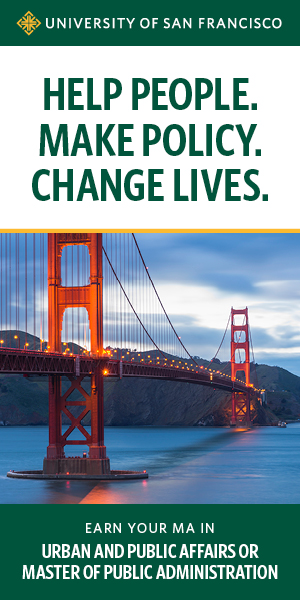George Moscone was the most influential mayor of San Francisco in the last quarter of the 20th century that you, most probably, never heard of, or if you did, it was because of his and Harvey Milk assassination on the same day, at the same place and by the same assassin.
That will change if you read Lincoln A. Mitchell’s Three Years Our Mayor: George Moscone and the Making of Modern San Francisco History (University of Nevada Press). And you should read it, cover to cover.
I knew Moscone, worked with him on district election of supervisors both before and after his election to mayor, volunteered on his campaign and once elected, and was hired by him to staff the Mayors Select Committee on Yerba Buena Center. It’s a measure of the man that even though I campaigned against his ballot measure to approve the convention center (later named after him), months later he and I worked successfully with a broad coalition to beat back the combined forces of the Chamber of Commerce and a disgruntled right wing zealot to repeal district elections.

Three Years Our Mayor skillfully recreates the San Francisco of the 1920 and 30’s as Moscone grew up in Cow Hollow. Mitchell is mainly correct in his recreation of the dynamics of San Francisco politics in the last half the 20th Century, paying attention to the demographic reality of neighborhoods and their relationship to the electoral system in San Francisco. He actually includes maps of voting patterns that starkly illustrate that reality, something most political writers on San Francisco fail to do—and without which their writing too often descends into mere opinion. Mitchell interrupts the maps and even precinct results to demonstrate his points, most of which are accurate.
But this focus on political dynamism and elections, though broadly accurate and deeply important in understanding Mitchell’s thesis of the importance of Moscone’s impact on San Francisco, it is also the books main limitation. Mitchell is a political scientist and as such pays way too much attention to elections and electioneering and not nearly enough about community organizing in non-election years. While getting the broader cultural changes happening in both California and San Francesco right, his focus on elections causes him to miss critically important people and movements during the period he writes about—people and movements of which George Moscone was completely aware.
For example, while Mitchell writes about the unity of opposition to redevelopment in the Western Addition between the Japanese and African American targets of urban renewal, he fails to discuss or even mention the critically important role of Yori Wada. Wada was the director of the Buchanan Street YMCA and was later appointed by Gov. Jerry Brown to be a regent of the University of California. The “Y” was a meeting ground between African American and Japanese youth, and its basketball games were famous for building teamwork and understanding between the two communities that made up Area A1 of the Western Addition Project Area.
Wada was a far sighted and dedicated community organizer who knew that only by combining the two communities resources could urban renewal be effectively challenged. The formation of the Western Addition Community Organization (WACO), made up both of African Americans of the Filmore and Japanese of Nihonmachi, bridging the Geary Street divide, was the practical manifestation of the unity created, in large part by Wada and the gym floor at the “Y.”
WACO sued the Redevelopment Agency in Federal Court and in 1968 won a landmark decision stopping the agency in its tracks and setting new legal precedents which allowed, according to the New York Times, “in that action was initiated by poor families residing the renewal area. Previously, the court had held that individuals from the community did not have standing in such matters.”
Within a year, Rep. Phil Burton got through Congress the Uniform Relocation Assistance Act based upon the case, which established as national law that if federal funds were used to displace a household federal funds had to be used to replace that unit—which totally transformed the object of Redevelopment in the Western Addition.
Mitchell also fails to inform his readers on the crucial role Sue Bierman played in the Moscone return to San Francisco, no doubt because she had no senior role in any of his campaigns. Bierman and Moscone grew close in the Freeway Revolt, when Bierman was a major community leader in the effort and Moscone a sympathetic vote on the Board of Supervisors. When then-state Senator Moscone decided he would return to San Francisco and run for mayor, he realized that the city had fundamentally changed while he was in Sacramento, and he needed someone to show him the new San Francisco. He correctly reasoned that Bierman was that person.
While Sue was a savvy and experienced Democratic campaign volunteer, Moscone also knew she was keenly interested in issues of importance to her neighbors, such as affordable housing and policing. Moscone asked Sue to set up a series of meetings with “new San Franciscans” and she did. In a two-week period, she drove Moscone (Bierman, the anti-freeway activist, drove her car everywhere and was the go-to driver for Jack Morrison, Willie Brown and George Moscone during campaigns) from meeting to meeting all over eastern San Francisco. Moscone learned just how San Francisco was changing and he was so thankful to Sue he appointed her to the Planning Commission, where she served for more than 20 years.
But perhaps the biggest oversight of the book is the failure to discuss the role of Richard Sklar in the Moscone administration. Sklar was initially brought in from Cleveland to take over the crisis with the Federal government and the Clean Water Act. The Feds were threatening to hold funding to the city and ban all new sewer hookups until the city had a plan and got underway a massive sewer re-build. the former mayor, Joe Alioto, simply ignored the problem as did the rest of the city bureaucracy, leaving the new Moscone administration “holding the bag.”
Sklar was an engineer, but he was an engineer with great political instincts and abilities. He was unshakably progressive, and, for example, chose a sewer-rebuild tax structure in which commercial uses and expensive real-estate paid a larger tax than did small residential uses.
In those days the city Public Utilities Commission had an ex-officio seat on the Planning Commission. As he heard one highrise commercial office project after another come before the commission, he begin to pick up Bierman’s concern over high rise office development. He knew that the city’s infrastructure was out of date and unable to continue to accommodate endless commercial development, and soon begun to question the approvals.
Indeed, it was his criticism of the pro-high rise policy of Moscone’s successor, Dianne Feinstein, that caused him to leave San Francisco office.
Moscone did more than endlessly raise money and run for office. He actually concerned himself with governing, and picked staff and selected programs that addressed peoples real needs. He, for example, re-oriented discretionary federal money away from the bureaucracy to fund new, community based non-profit housing development corporations as a result of his failed attempt to secure the I-Hotel and have an alternative to handing it over to the Housing Authority. A score of community and faith-based nonprofits were funded under his administration, eventually resulting in the development of some 40,000 units of housing built, re-habilitated and acquired, removing them all from the speculative market.
These three examples—Yori Wada, Sue Bierman and Dick Sklar—were part or became part of a politics not built on elections, campaigns and contributions, but a politics based upon using government to solve real people’s real issues, one that Moscone felt totally comfortable in and one he was good at. What a contrast with the last three mayors, who seemed to be happy with taking other people’s money and then doing their bidding. Moscone was, if anything, more interested in governing than electoral politics. What a wonder then—but especially now.
Mitchell’s Three Years Our Mayor, is a first-rate book correcting a for too long the ignoring of Moscone’s time in the city’s politics. He was thoughtful and empathic and had the ability to light up a room upon his entrance for everyone there, unlike any other San Franciscan leader I have met before or since. Mitchell captures the spirit of the time with his well-written work. I shall add it to my short list of “must reads” on San Francisco politics.
Order Three Years Our Mayor from your local independent bookstore, or online here.




